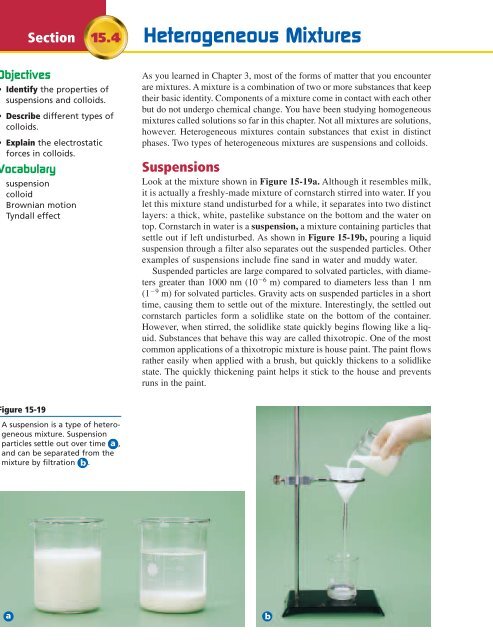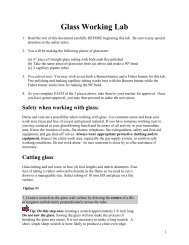Chapter 15: Solutions - Weironline.net
Chapter 15: Solutions - Weironline.net
Chapter 15: Solutions - Weironline.net
You also want an ePaper? Increase the reach of your titles
YUMPU automatically turns print PDFs into web optimized ePapers that Google loves.
Objectives<br />
Section <strong>15</strong>.4 Heterogeneous Mixtures<br />
• Identify the properties of<br />
suspensions and colloids.<br />
• Describe different types of<br />
colloids.<br />
• Explain the electrostatic<br />
forces in colloids.<br />
Vocabulary<br />
suspension<br />
colloid<br />
Brownian motion<br />
Tyndall effect<br />
Figure <strong>15</strong>-19<br />
A suspension is a type of heterogeneous<br />
mixture. Suspension<br />
particles settle out over time a ,<br />
and can be separated from the<br />
mixture by filtration b .<br />
a b<br />
476 <strong>Chapter</strong> <strong>15</strong> <strong>Solutions</strong><br />
As you learned in <strong>Chapter</strong> 3, most of the forms of matter that you encounter<br />
are mixtures. A mixture is a combination of two or more substances that keep<br />
their basic identity. Components of a mixture come in contact with each other<br />
but do not undergo chemical change. You have been studying homogeneous<br />
mixtures called solutions so far in this chapter. Not all mixtures are solutions,<br />
however. Heterogeneous mixtures contain substances that exist in distinct<br />
phases. Two types of heterogeneous mixtures are suspensions and colloids.<br />
Suspensions<br />
Look at the mixture shown in Figure <strong>15</strong>-19a. Although it resembles milk,<br />
it is actually a freshly-made mixture of cornstarch stirred into water. If you<br />
let this mixture stand undisturbed for a while, it separates into two distinct<br />
layers: a thick, white, pastelike substance on the bottom and the water on<br />
top. Cornstarch in water is a suspension, a mixture containing particles that<br />
settle out if left undisturbed. As shown in Figure <strong>15</strong>-19b, pouring a liquid<br />
suspension through a filter also separates out the suspended particles. Other<br />
examples of suspensions include fine sand in water and muddy water.<br />
Suspended particles are large compared to solvated particles, with diameters<br />
greater than 1000 nm (10 �6 m) compared to diameters less than 1 nm<br />
(1 �9 m) for solvated particles. Gravity acts on suspended particles in a short<br />
time, causing them to settle out of the mixture. Interestingly, the settled out<br />
cornstarch particles form a solidlike state on the bottom of the container.<br />
However, when stirred, the solidlike state quickly begins flowing like a liquid.<br />
Substances that behave this way are called thixotropic. One of the most<br />
common applications of a thixotropic mixture is house paint. The paint flows<br />
rather easily when applied with a brush, but quickly thickens to a solidlike<br />
state. The quickly thickening paint helps it stick to the house and prevents<br />
runs in the paint.




